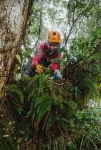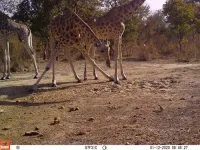(Press-News.org) While much of the global concern has subsided, COVID-19 is still a very real threat, especially to people with compromised immune systems or who are over 65.
Vaccination offers excellent protection against serious illness and death, but the current vaccines have room for improvement in their ability to stop the spread of SARS-CoV-2 at the point of entry in the upper respiratory tract.
A collaborative research effort led by the University of Michigan and the Icahn School of Medicine at Mount Sinai has resulted in a nasal vaccine adjuvant that stops infection in both young and old mice.
An adjuvant is a substance added to some vaccines to trigger a stronger immune response, boosting their effectiveness. Several current vaccines contain adjuvants and they are often recommended for people over 65.
The new vaccine protocol, developed by Pamela Wong, Ph.D., and Michael Schotsaert, Ph.D., and their teams, combines a nanoemulsion—think of a tiny droplet of oil and water –and an RNA-based molecule that is recognized by the immune system similar to how viral infection is sensed as an intranasal adjuvant to help trigger immune responses in the upper respiratory system.
“There is considerable interest in intranasal vaccines for respiratory viruses because inducing mucosal immunity can help prevent viral transmission, whereas injectable vaccines don’t effectively elicit mucosal immune responses,” said Wong, a research assistant professor in the U-M Medical School Department of Internal Medicine.
Wong and Schotsaert, an assistant professor of microbiology at Icahn Mount Sinai, both recognized the value of—and challenges posed by—an adjuvanted intranasal vaccine delivery system and their teams have been working together for almost a decade to create one that results in a good immune response.
Their protocol combines the best of both components: the RNA adjuvant triggers antiviral pathways inside the cell while the nanoemulsion carries it into the cell and helps prevent it from being cleared too quickly from inside the nasal passages, while also activating immune pathways complementary to the one triggered by the RNA adjuvant.
Testing their adjuvant with the SARS-CoV-2 receptor binding domain protein—which the virus uses to enter a host’s cells—the combined vaccine led to the enhancement of antibody and memory T cell responses in both young and old mice, including in the mucosa of the upper airway where the virus starts to proliferate.
“It’s very hard to induce a strong immune response with intranasal vaccines containing just the protein or inactivated virus alone because your mucosal sites will see many things during the day or over a lifetime and are to some extent ‘trained’ not to overreact. So, you want to overcome that barrier through the use of adjuvants while balancing safety,” said Schotsaert.
Furthermore, the intranasal vaccine outperformed the intramuscular adjuvant Addavax in old mice, which is similar to the adjuvant currently used in the flu vaccine for the elderly, in its ability to generate viral neutralizing antibodies and T cell responses.
Despite its promise, the road to an adjuvant for nasal delivery has been a rocky one. There is only one commonly used, FDA- approved nasal vaccine in the United States, FluMist, and it does not contain an adjuvant nor is it recommended for people over 49.
An adjuvanted nasal flu vaccine was licensed in Switzerland, only to be pulled from the market in 2000 after reports of Bell’s palsy, a form of facial paralysis, in some people who received the vaccine.
Spurred by the COVID pandemic, several other intranasal vaccines have been explored but have either resulted in short-lived protection or a poor immune response.
On the contrary, the team’s combined adjuvanted intranasal vaccine appears to result in highly effective and long-lasting immunity against SARS-CoV2 in a preclinical model. What’s more, the nanoemulsion has an additional feature: it can inactivate viruses on its own.
“This means you could mix live virus with the nanoemulsion and it would inactivate it without having to use harsher chemical methods, better preserving the conformation of the viral proteins that the immune system sees, potentially leading to better quality immune responses,” said Wong.
Next, the team plans to pursue additional studies necessary for bringing the adjuvant to Phase 1 safety trials as well as exploring its applications for a universal flu vaccine.
Paper cited: “Multicomponent intranasal adjuvant for mucosal and durable systemic SARS-CoV-2 immunity in young and aged mice,” NPJ Vaccines. DOI: 10.1038/s41541-023-00691-1
END
An adjuvanted intranasal vaccine for COVID-19 protects both young and old mice
The vaccine could stop the spread of SARS-CoV-2 at the point of entry in the upper respiratory tract
2023-08-04
ELSE PRESS RELEASES FROM THIS DATE:
Five ORNL scientists to receive DOE Early Career Research awards
2023-08-04
The Department of Energy’s Office of Science has selected five Oak Ridge National Laboratory scientists for Early Career Research Program awards.
Since its inception in 2010, the program bolsters national scientific discovery by supporting early career researchers in fields pertaining to the Office of Science's eight major program offices: Advanced Scientific Computing Research, Biological and Environmental Research, Basic Energy Sciences, Fusion Energy Sciences, High Energy Physics, Nuclear Physics, Accelerator R&D and Production and Isotope R&D and Production.
Award ...
In the treetops: USU ecologist studies canopy soil abundance, chemistry
2023-08-04
LOGAN, UTAH, USA - When we think of soil, most of us think of dirt on the ground. But a surprising amount of the planet’s soil thrives in the treetops of old-growth forests, high above terra firma.
This organic matter, composed of decaying leaves and branches, airborne particulates and moisture, is called canopy soil or arboreal soil. Its study is relatively new, says Utah State University ecologist Jessica Murray. She’s among researchers unraveling mysteries of the dense, mossy humus that provides rich habitat for insects, birds, fungi, worms and plants, as well as a generous reservoir for carbon storage.
Murray and colleagues from Texas ...
HSE researchers question the correctness of experiments denying free will
2023-08-04
Neuroscientists from HSE University have criticized the famous studies that question the free will of our decisions. You can’t shift responsibility for your actions to the brain. The results of the new work were published in the Neuropsychologia journal.
The dispute about how much free will people have in making their decisions has been going for decades. Neuroscientists have joined this discussion thanks to the electroencephalographic (EEG) experiments of Benjamin Libet. In the 1970-1980s, he showed that 0.5–1.5 seconds before conscious awareness of the intention to perform a movement, subjects ...
Kordofan giraffes face local extinction if poaching continues
2023-08-04
For immediate release
Friday 4 August 2023
Kordofan giraffes face local extinction if poaching continues
Poaching of two Critically Endangered Kordofan giraffes per year could result in extinction in just 15 years within Cameroon’s Bénoué National Park without intervention. These are the alarming new findings of a University of Bristol and Bristol Zoological Society-led study published in the African Journal of Ecology.
One of the last populations of Kordofan giraffes roam Cameroon's Bénoué ...
Team creates power generator that runs on natural atmospheric humidity
2023-08-04
Scientists are looking for ways to use the low-value energy widely distributed in natural environments to generate electricity. A research team has created a power generator that collects the natural atmospheric humidity and produces continuous electrical signals. This is the first humidity generator designed using a nano-sized material called polyoxometalates. It holds the potential of being a new research direction for polyoxometalates in the sustainable utilization of low-value energy.
The team’s work is published in the journal Nano Research on August 01.
The team set out to solve ...
New deep-learning approach gets to the bottom of colonoscopy
2023-08-04
Researchers have developed a pair of modules that gives a boost to the use of artificial neural networks to identify potentially cancerous growths in colonoscopy imagery, traditionally plagued by image noise resulting from the colonoscopy insertion and rotation process itself.
A paper describing the approach was published in the journal CAAI Artificial Intelligence Research on June 30.
Colonoscopy is the gold standard for detecting colorectal growths or ‘polyps’ in the inner lining of your colon, also known as the large intestine. ...
Influenza shows no seasonality in tropics, posing challenges for health care
2023-08-04
UNIVERSITY PARK, Pa. — In temperate climates, like North America and Europe, flu season starts in the fall, peaks in the winter and ends in the spring. While public health officials have generally assumed that influenza is also seasonal in tropical climates, new research led by Penn State has found little evidence of a repeatable pattern in influenza cases in Vietnam. The findings suggest that influenza is likely unpredictable throughout the tropics, posing substantial challenges for prevention and management of cases for the one-third of the global population living in tropical areas.
“The World ...
Prevalence, risk factors for school-associated transmission of SARS-CoV-2
2023-08-04
About The Study: In this study of Massachusetts schools, the secondary attack rate for SARS-CoV-2 among school-based contacts was low during two periods, and factors associated with transmission risk varied over time. These findings suggest that ongoing surveillance efforts may be essential to ensure that both targeted resources and mitigation practices remain optimal and relevant for disease prevention.
Authors: Sandra B. Nelson, M.D., of Massachusetts General Hospital in Boston, is the corresponding author.
To access the embargoed study: Visit our For The Media website at this link https://media.jamanetwork.com/
(doi:10.1001/jamahealthforum.2023.2310)
Editor’s ...
Racial, ethnic disparities in survival among people with second primary cancer
2023-08-04
About The Study: In this study of 230,000 persons with second primary cancers in the U.S., the Black population had a higher risk of death from both cancer and cardiovascular disease compared with the white population, whereas the Hispanic population had a higher risk of death from cancer. These results suggest that research priorities to address survival disparities in the growing population of survivors of multiple primary cancers are warranted.
Authors: Hyuna Sung, Ph.D., of the American Cancer Society in Atlanta, is ...
New study shows substantial racial and ethnic disparities among survivors of second primary cancers in the US
2023-08-04
ATLANTA, August 4, 2023 — In new findings from researchers at the American Cancer Society (ACS), non-Hispanic Black individuals diagnosed with a second primary cancer (SPC) experienced 21% higher cancer-related death rates and 41% higher cardiovascular-related death rates compared with their non-Hispanic White counterparts. The study also showed that Hispanic individuals diagnosed with a second primary cancer also experienced 10% higher cancer-related death rates compared with their non-Hispanic White counterparts, but 10% lower cardiovascular-related death rates. The paper was published ...
LAST 30 PRESS RELEASES:
Norbert Holtkamp appointed director of Fermi National Accelerator Laboratory
New agentic AI platform accelerates advanced optics design
Biologists discover neurons use physical signals — not electricity — to stabilize communication
Researchers discover that a hormone can access the brain by hitchhiking
University of Oklahoma researcher awarded funding to pursue AI-powered material design
Exploring how the visual system recovers following injury
Support for parents with infants at pediatric check-ups leads to better reading and math skills in elementary school
Kids’ behavioral health is a growing share of family health costs
Day & night: Cancer disrupts the brain’s natural rhythm
COVID-19 vaccination significantly reduces risk to pregnant women and baby
The role of vaccination in maternal and perinatal outcomes associated with COVID-19 in pregnancy
Mayo Clinic smartwatch system helps parents shorten and defuse children's severe tantrums early
Behavioral health spending spikes to 40% of all children’s health expenditures, nearly doubling in a decade
Digital cognitive behavioral treatment for generalized anxiety disorder
Expenditures for pediatric behavioral health care over time and estimated family financial burden
Air conditioning in nursing homes and mortality during extreme heat
The Alps to lose a record number of glaciers in the next decade
What makes a good proton conductor?
New science reporting guide published for journalists in Bulgaria
New international study reveals major survival gaps among children with cancer
New science reporting guide published for journalists in Turkey
Scientists develop a smarter mRNA therapy that knows which cells to target
Neuroanatomy-informed brain–machine hybrid intelligence for robust acoustic target detection
Eight SwRI hydrogen projects funded by ENERGYWERX
The Lundquist Institute and its start-up company Vitalex Biosciences Announces Strategic Advancement of Second-Generation fungal Vaccine VXV-01 through Phase 1 Trials under $40 Million Competitive Con
Fine particles in pollution are associated with early signs of autoimmune disease
Review article | Towards a Global Ground-Based Earth Observatory (GGBEO): Leveraging existing systems and networks
Penn and UMich create world’s smallest programmable, autonomous robots
Cleveland researchers launch first major study to address ‘hidden performance killer’ in athletes
To connect across politics, try saying what you oppose
[Press-News.org] An adjuvanted intranasal vaccine for COVID-19 protects both young and old miceThe vaccine could stop the spread of SARS-CoV-2 at the point of entry in the upper respiratory tract




